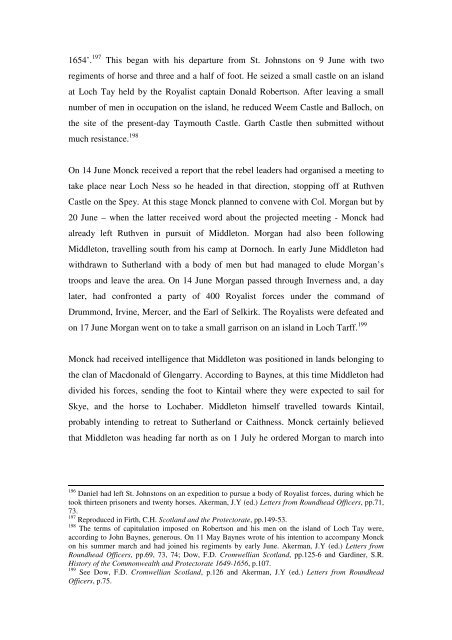The Glencairn Uprising, 1653-54 Helen Baker Department of ...
The Glencairn Uprising, 1653-54 Helen Baker Department of ...
The Glencairn Uprising, 1653-54 Helen Baker Department of ...
You also want an ePaper? Increase the reach of your titles
YUMPU automatically turns print PDFs into web optimized ePapers that Google loves.
16<strong>54</strong>’. 197 This began with his departure from St. Johnstons on 9 June with two<br />
regiments <strong>of</strong> horse and three and a half <strong>of</strong> foot. He seized a small castle on an island<br />
at Loch Tay held by the Royalist captain Donald Robertson. After leaving a small<br />
number <strong>of</strong> men in occupation on the island, he reduced Weem Castle and Balloch, on<br />
the site <strong>of</strong> the present-day Taymouth Castle. Garth Castle then submitted without<br />
much resistance. 198<br />
On 14 June Monck received a report that the rebel leaders had organised a meeting to<br />
take place near Loch Ness so he headed in that direction, stopping <strong>of</strong>f at Ruthven<br />
Castle on the Spey. At this stage Monck planned to convene with Col. Morgan but by<br />
20 June – when the latter received word about the projected meeting - Monck had<br />
already left Ruthven in pursuit <strong>of</strong> Middleton. Morgan had also been following<br />
Middleton, travelling south from his camp at Dornoch. In early June Middleton had<br />
withdrawn to Sutherland with a body <strong>of</strong> men but had managed to elude Morgan’s<br />
troops and leave the area. On 14 June Morgan passed through Inverness and, a day<br />
later, had confronted a party <strong>of</strong> 400 Royalist forces under the command <strong>of</strong><br />
Drummond, Irvine, Mercer, and the Earl <strong>of</strong> Selkirk. <strong>The</strong> Royalists were defeated and<br />
on 17 June Morgan went on to take a small garrison on an island in Loch Tarff. 199<br />
Monck had received intelligence that Middleton was positioned in lands belonging to<br />
the clan <strong>of</strong> Macdonald <strong>of</strong> Glengarry. According to Baynes, at this time Middleton had<br />
divided his forces, sending the foot to Kintail where they were expected to sail for<br />
Skye, and the horse to Lochaber. Middleton himself travelled towards Kintail,<br />
probably intending to retreat to Sutherland or Caithness. Monck certainly believed<br />
that Middleton was heading far north as on 1 July he ordered Morgan to march into<br />
196 Daniel had left St. Johnstons on an expedition to pursue a body <strong>of</strong> Royalist forces, during which he<br />
took thirteen prisoners and twenty horses. Akerman, J.Y (ed.) Letters from Roundhead Officers, pp.71,<br />
73.<br />
197 Reproduced in Firth, C.H. Scotland and the Protectorate, pp.149-53.<br />
198 <strong>The</strong> terms <strong>of</strong> capitulation imposed on Robertson and his men on the island <strong>of</strong> Loch Tay were,<br />
according to John Baynes, generous. On 11 May Baynes wrote <strong>of</strong> his intention to accompany Monck<br />
on his summer march and had joined his regiments by early June. Akerman, J.Y (ed.) Letters from<br />
Roundhead Officers, pp.69, 73, 74; Dow, F.D. Cromwellian Scotland, pp.125-6 and Gardiner, S.R.<br />
History <strong>of</strong> the Commonwealth and Protectorate 1649-1656, p.107.<br />
199 See Dow, F.D. Cromwellian Scotland, p.126 and Akerman, J.Y (ed.) Letters from Roundhead<br />
Officers, p.75.
















